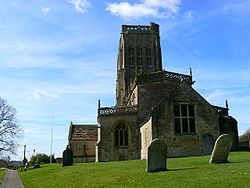Batcombe, Somerset: Difference between revisions
Created page with "{{Infobox town |name=Batcombe |county=Somerset |picture=Batcombe church.jpg |picture caption=Church of St Mary the Virgin, Batcombe |os grid ref=ST695395 |latitude=51.1538 |lo..." |
m →Parish church: ioe -> nhle, replaced: {{IoE|268216 → {{NHLE|1234822 |
||
| (One intermediate revision by one other user not shown) | |||
| Line 20: | Line 20: | ||
==Parish church== | ==Parish church== | ||
The Church of St Mary the Virgin dates from the 15th and 16th centuries and was restored in the 19th. The tower contains five bells dating from 1760 and made by Thomas Bilbie, of the Bilbie family, in [[Cullompton]].<ref>{{cite book |last=Moore |first=James |authorlink=|author2=Rice, Roy |author3=Hucker, Ernest |title=Bilbie and the Chew Valley clock makers |year=1995 |publisher=The authors |location=|isbn=0-9526702-0-8 }}</ref> | The Church of St Mary the Virgin dates from the 15th and 16th centuries and was restored in the 19th. The tower contains five bells dating from 1760 and made by Thomas Bilbie, of the Bilbie family, in [[Cullompton]].<ref>{{cite book |last=Moore |first=James |authorlink=|author2=Rice, Roy |author3=Hucker, Ernest |title=Bilbie and the Chew Valley clock makers |year=1995 |publisher=The authors |location=|isbn=0-9526702-0-8}}</ref> | ||
The church It has been designated a Grade I listed building.<ref>{{ | The church It has been designated a Grade I listed building.<ref>{{NHLE|1234822|Church of St Mary the Virgin}}</ref> | ||
==History== | ==History== | ||
Latest revision as of 21:56, 18 September 2019
| Batcombe | |
| Somerset | |
|---|---|
 Church of St Mary the Virgin, Batcombe | |
| Location | |
| Grid reference: | ST695395 |
| Location: | 51°9’14"N, 2°26’7"W |
| Data | |
| Population: | 439 (2011) |
| Post town: | Shepton Mallet |
| Postcode: | BA4 |
| Dialling code: | 01749 |
| Local Government | |
| Council: | Mendip |
Batcombe is a village in the Mendip Hills of Somerset, sitting in the steep valley of the River Alham five miles south-east of Shepton Mallet. The parish had a recorded population of 439 at the 2011 census.
Within the parish are also the hamlets of Westcombe, Spargrove and Eastcombe (historically Ashcombe).
Parish church
The Church of St Mary the Virgin dates from the 15th and 16th centuries and was restored in the 19th. The tower contains five bells dating from 1760 and made by Thomas Bilbie, of the Bilbie family, in Cullompton.[1]
The church It has been designated a Grade I listed building.[2]
History
The name Batcombe comes from Old English and apparently means 'Bat's Valley' after an otherwise unknown local landowner.[3]
Around a mile from the hamlet of Westcombe is a hill fort on Smalldown Knoll which dates back to the Iron Age and possibly the Bronze Age.
Batcombe and Westcombe are recorded in the Domesday Book of 1086.
Westcombe was for many years property of Glastonbury Abbey which was destroyed with the Dissolution of the Monasteries. As will all the Mendip villages, sheep were the soul of the economy until the modern age, and the woollen industry was strong in Batcombe.
For a long time the Bisse family owned much property in Batcombe, as well as other local villages, including Spargrove.
In the 1643, a mass fight broke out between the people of Batcombe and the people of Bruton.[4] Known to the local people as the 'Battle of Batcombe', the fight was because Batcombe was becoming a rival to Bruton in the wool industry of in which Bruton was a major player at the time. Although Batcombe is smaller it had a defensive advantage as it is on a hill. It is reported that the men of Bruton won the battle.
Batcombe has a war memorial dedicated to those who gave their lives in First World War. The war memorial in Westcombe has engraved on it around 12 names. It was originally a family memorial to Henry Ernst in 1913, but it was later converted to a War memorial in 1919.
The property in Westcombe was historically owned by a single family, the Ernst family who lived in the Georgian country house of Westcombe House. Most of the estate was sold in 1927, and divided between two daughters. One inherited Westcombe House and the other all the family's wealth. The house fell into disrepair, and was demolished in the early 1950s. Today the hamlet is home to a small industrial site owned mainly by Milton-Westcombe Farms Limited. The largest business operation on site is that of the Bay Tree Food Company, which produces handmade pickled and jam goods sold across the UK.
Society
In 1933 Batcombe village hall was built next to the village school. The hall was constructed largely of timber and built by local villagers. By the 1990s the hall's age was beginning to show, and it was clearly rotting so in 2001 it was demolished and the foundations laid for the new hall. The "Batcombe Jubilee Hall" was completed in May 2002, and officially opened by HRH Prince Charles on 25 May 2002.
The Jubilee Hall is mainly of stone construction, with two sides made of external timber. In all the project cost over £500,000. The hall is run by the Batcombe Village Hall Trust, a charitable organisation of volunteers.
The village has a King George V Playing Field, of just half an acre, created in memorial to the King and for the benefit of the villagers.
Outside links
| ("Wikimedia Commons" has material about Batcombe, Somerset) |
References
- ↑ Moore, James; Rice, Roy; Hucker, Ernest (1995). Bilbie and the Chew Valley clock makers. The authors. ISBN 0-9526702-0-8.
- ↑ National Heritage List 1234822: Church of St Mary the Virgin
- ↑ Scott, Shane (1995). The hidden places of Somerset. Aldermaston: Travel Publishing Ltd. p. 68. ISBN 1-902007-01-8.
- ↑ Bruton – British History Online
